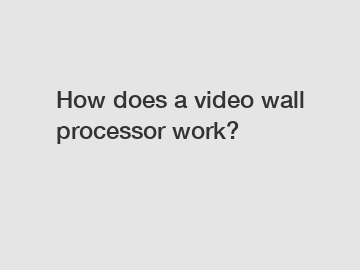Dec. 18, 2023
Office & School Supplies
How Does a Video Wall Processor Work?
Video walls have become a popular option for digital signage and visual display purposes in various settings, such as control rooms, stadiums, retail stores, and corporate offices. These large-scale displays consist of multiple screens or projectors that are arranged in a grid-like formation to create a single unified image or video. To achieve this cohesive and seamless display, a video wall processor is employed. In this article, we will explore the inner workings of a video wall processor, including its components, functions, and benefits.
What is a Video Wall Processor?

A video wall processor, also known as a video wall controller or video wall system, is a hardware device or software application that connects to multiple input sources and outputs them to an array of displays. Its primary function is to divide, process, and distribute video signals across the screens of a video wall in real-time, providing a synchronized and visually appealing display. A video wall processor acts as the brain behind the video wall, ensuring the content is seamlessly displayed without any disruptions or delays.
Components of a Video Wall Processor.
1. Inputs: A video wall processor can handle various video sources, including HDMI, DVI, VGA, or IP streams. It allows users to connect multiple input devices simultaneously, such as computers, media players, Blu-ray players, or cameras, which are then combined and presented collectively on the video wall.
2. Video Wall Controller: The controller is the core component of the video wall processor. It manages the content distribution and display across the screens. A powerful video wall controller can support a high number of screens and input sources, allowing for greater flexibility and scalability.
Functions of a Video Wall Processor.
1. Video Wall Configuration: The video wall processor allows users to define the layout and arrangement of the screens, specifying the number of rows and columns, screen sizes, and bezel compensation. This configuration ensures a precise alignment of the screens to create a seamless, uninterrupted visual display.
2. Content Management: Video wall processors enable users to manage and control the content displayed on the video wall. They provide options for switching between different input sources, displaying multiple windows simultaneously, or zooming in on specific sections of the content. Additionally, content can be resized, rotated, or flipped to fit the desired configuration of the video wall.
3. Real-time Video Processing: One of the key functions of a video wall processor is its ability to process video signals in real-time. It ensures that the video content is seamlessly distributed across the screens without any delays or latency issues.
Benefits of Using a Video Wall Processor.
1. Enhanced Visual Experience: By utilizing a video wall processor, users can create stunning visual displays that captivate the audience. The processor allows for the integration of high-resolution images, videos, and 3D content, resulting in an immersive viewing experience.
2. Easy Installation and Maintenance: Video wall processors simplify the installation and maintenance of video walls. The processors come with user-friendly interfaces and intuitive software applications that enable users to manage and control the video wall effortlessly.
3. Scalability: Video wall processors offer scalability options, allowing users to expand the video wall as needed. Additional screens and sources can be easily integrated into the existing system without requiring any major reconfiguration or system overhauls.
In conclusion, a video wall processor is a crucial component in creating seamless and visually appealing video wall displays. It serves as the central hub for managing, processing, and distributing video content across multiple screens. By utilizing a video wall processor, users can achieve a synchronized and immersive visual experience. If you are interested in implementing a video wall processor for your display needs, feel free to contact us for further assistance.
Contact us today for all your video wall processor requirements and let our experts guide you through the process.
If you want to learn more, please visit our website Audio Conferencing System, conference screen, conference room audio and video equipment.
Previous: Which Professional HDMI Camera Switcher and Recorder is the Best for a Seamless Purchase Experience?
Next: Which Digital Discussion System Enables Seamless Collaboration?
If you are interested in sending in a Guest Blogger Submission,welcome to write for us!
All Comments ( 0 )